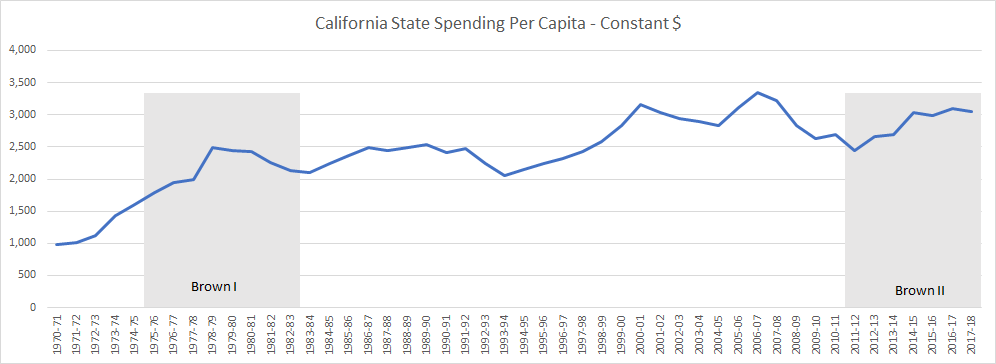Brown’s latest budget belies his fiscally conservative rhetoric
At last week’s budget press conference, Governor Jerry Brown warned of the threat of a recession and the risk to California’s budget from federal health care legislation, but the details of his 2017-18 budget plans failed to mirror his cautionary rhetoric.
Despite disappointing 2016-17 revenue results, Governor Brown has proposed increased 2017-18 spending in his May budget revise. Between the release of the Governor’s Budget in January and the May revision, Brown raised his proposal for total state fund spending from $179 billion to $183 billion (these amounts exclude $105 billion in federal funds the state also expects to spend in the fiscal year starting July 1).
About $1.5 billion of the overall $4 billion increase is attributable to the state’s General Fund. Since the General Fund will not receive SB1 gas tax revenues, the new spending must be balanced by a rosier outlook for income tax revenues. While this may be possible due to a post-election bounce in the stock market, it is consistent with neither Brown’s cautious tone nor the disappointing tax collections for the current fiscal year. This year’s General Fund revenues are now expected to total $118.5 billion or $1.8 billion below budget. The general fund is expected to run $3.8 billion deficit in 2016-17 and to end the year with a reserve of just $700 million.
If, in fact, California is facing a recession and is at risk of losing federal health care dollars, the budget should have contained a large surplus. At the press conference, Brown framed his role as one of restraining legislators who want greater increases. It is true that many legislative Democrats want to spend more, but it is not clear that Brown must compromise with them. Since the Governor has a line item veto, he could simply strike individual spending initiatives from the budget once it passes. Also, since Brown cannot seek re-election, he need no longer toe the party line. He might have instead offered a budget which would lose some liberal Democrats in exchange for moderate Republicans.
While the Governor talks like a fiscal conservative, his actual spending record is decidedly progressive. As the accompanying chart shows, spending on a per resident, inflation adjusted basis increased during his first regime from 1975 to 1983 and is increasing again under his post 2010 restoration.

And Brown is planning even more spending on his way out of Sacramento. At the press conference, Brown discussed his efforts to push a new cap and trade bill through the legislature. The proposal would extend cap and trade auctions for another ten years, sun setting them in 2030 rather than 2020. Although three of the last four auctions failed, Brown is hoping that the extension will rejuvenate this revenue source. But, rather than use cap and trade revenues to provide a fiscal cushion, Brown plans to devote auction proceeds to various climate change priorities including local mass transit and high-speed rail.
Asked about high-speed rail by a reporter, Brown responded “What about it? It’s speeding ahead.” He also pushed back against suggestions that the federal government would cut off funding, and quoted a survey stating that 58% of people in the Central Valley now support the project. Given the state government’s resistance to federal policies and united opposition to the bullet train among Congressional Republicans, the odds of new federal funds for high-speed rail under the Trump administration are negligible. As for the Central Valley support for the project, the 58% figure included non-voters; when only those who voted in the Presidential election are counted, support shrinks to 47%.
If Brown was really serious about the state’s long term fiscal health, he would find a way to end the high-speed rail program and freeze other spending at current levels.
